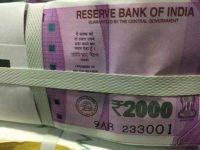
In a surprising move that is unmatched in India’s currency history, the government has decided to withdraw two of India’s most circulating highest denomination notes. From midnight, today onwards Rs 500 and Rs 1000 will be replaced with new Rs 500 and Rs 2000 notes. These two notes constitute to nearly 83% value of currency notes in circulation according to the RBI.
While announcing the withdrawal, government has pointed out the mechanism for exchanging the existing high denomination notes for new notes. The existing notes will be accepted at railway stations, bus stands, post offices, besides banks. People get 50 days until December 31 to return the notes, PM has said. Government-run hospitals can also accept the notes until Nov. 11. Several facilities are deployed by the government for executing the sudden decision.
But the government step of withdrawing the notes not seems to be sudden. Deploymentt of necessary arrangement shows more planning. Recent circulation of photographs about Rs 2000 notes indicate that government was preparing for the step for some time.
Why the currency note withdrawal?
Why this surprising and often potentially chaos causing step? The most powerful reason is to attack counterfeit notes or fake currencies. Prime Minister has cited the unholy nexus of corruption, black money and terrorism for taking the step.
But of these, what tempted the government for this sudden but well thought out step is to prevent to tackle counterfeit notes or fake notes.
Over the last several years, Pakistan was fighting India by dumping counterfeit notes. Such notes have become a menace and in the context of the recent Surgical Operations, intelligence reports were highlighting the possibility of Pakistan using its ‘strike force’ to distribute counterfeit notes in India.
Black money is another objective. But if it was the leading objective, government would have several other options like making PAN mandatory for high-value transactions. They would be less disturbing compared to the current move.
Certain sectors like real estate and trading will get a shock treatment as these areas are supposed to be the traditional havens of black money. But bulk of black money is not stored in the form of cash; but rather in physical forms and fictitious accounts. Only those black money stored in cash will be caught.
November 9, the difficult day
An interesting side is how India will adjust to this bumpy experiment. Notes can be exchanged till December 31. Government should demonstrate the public that the entire exercise will be done with minimum trouble.
But the most difficult day will be November 9, with no bank and no ATM functioning according to Government directions.
Hero is Rs 100 note
Reports indicate that the RBI has instructed banks to fill Rs 100 notes in the coming days. RBI already suggested banks to use 10% Rs 100 notes.
*********











